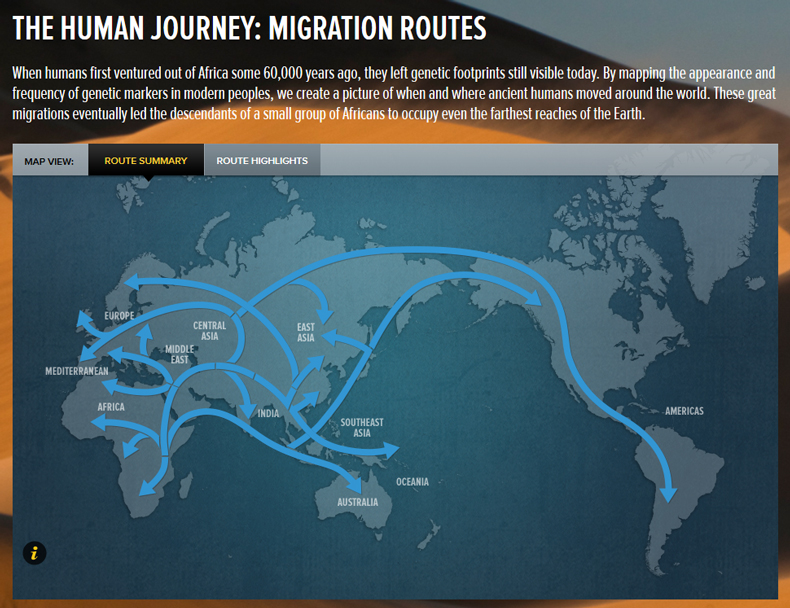
Mechanisms of Evolutionary Change
(Natural Selection, Genetic Drift, Mutations and Gene Flow)
Microevolution (evolution on a small-scale) refers to the changes in allele frequencies within a single population. Allele frequencies in a population may change due to four fundamental forces of evolution: Natural Selection, Genetic Drift, Mutations and Gene Flow. Mutations are the ultimate source of new alleles in a gene pool.
Two of the most relevant mechanisms of evolutionary change are: Natural Selection and Genetic Drift. One of the main controversial issues in population genetics is concerned with the relative importance of both mechanisms in determining evolutionary changes. Natural selection usually predominates in large populations whereas genetic drift does so in small ones.
Two of the most relevant mechanisms of evolutionary change are: Natural Selection and Genetic Drift. One of the main controversial issues in population genetics is concerned with the relative importance of both mechanisms in determining evolutionary changes. Natural selection usually predominates in large populations whereas genetic drift does so in small ones.

1.- Natural Selection
Natural Selection leads to an evolutionary change when some individuals with certain traits in a population have a higher survival and reproductive rate than others and pass on these inheritable genetic features to their offspring. Evolution acts through natural selection whereby reproductive and genetic qualities that prove advantageous to survival prevail into future generations. The cumulative effects of natural selection process have giving rise to populations that have evolved to succeed in specific environments. Natural selection operates by differential reproductive success (fitness) of individuals.
The Darwin’s Finches diagram illustrates the way the finch has adapted to take advantage of feeding in different ecological niches:
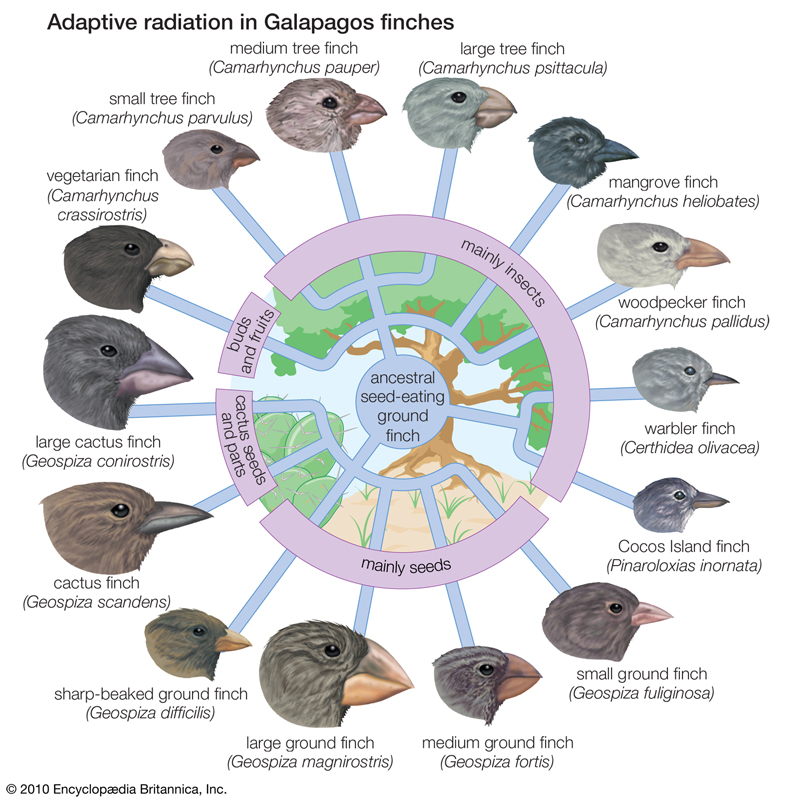

2.- Genetic Drift
Random Drift consists of random fluctuations in the frequency of appearance of a gene, usually, in a small population. The process may cause gene variants to disappear completely, thereby reducing genetic variability. In contrast to natural selection, environmental or adaptive pressures do not drive changes due to genetic drift. The effect of genetic drift is larger in small populations and smaller in large populations.
 Genetic drift is a stochastic process, a random event that happens by chance in nature that influences or changes allele frequency within a population as a result of sampling error from generation to generation. It may happen that some alleles are completely lost within a generation due to genetic drift, even if they are beneficial traits that conduct to evolutionary and reproductive success. Allele is defined as any one of two or more genes that may occur alternatively at a given site (locus) on a chromosome. Alleles are responsible for variations in a trait.
The population bottleneck and a founder effect are two examples of random drift that can have significant effects in small populations. Genetic drift works on all mutations and can eventually contribute to the creation of a new species by means of the accumulation of non-adaptive mutations that can facilitate population subdivision.
Genetic drift is a stochastic process, a random event that happens by chance in nature that influences or changes allele frequency within a population as a result of sampling error from generation to generation. It may happen that some alleles are completely lost within a generation due to genetic drift, even if they are beneficial traits that conduct to evolutionary and reproductive success. Allele is defined as any one of two or more genes that may occur alternatively at a given site (locus) on a chromosome. Alleles are responsible for variations in a trait.
The population bottleneck and a founder effect are two examples of random drift that can have significant effects in small populations. Genetic drift works on all mutations and can eventually contribute to the creation of a new species by means of the accumulation of non-adaptive mutations that can facilitate population subdivision.
 Genetic drift is a stochastic process, a random event that happens by chance in nature that influences or changes allele frequency within a population as a result of sampling error from generation to generation. It may happen that some alleles are completely lost within a generation due to genetic drift, even if they are beneficial traits that conduct to evolutionary and reproductive success. Allele is defined as any one of two or more genes that may occur alternatively at a given site (locus) on a chromosome. Alleles are responsible for variations in a trait.
The population bottleneck and a founder effect are two examples of random drift that can have significant effects in small populations. Genetic drift works on all mutations and can eventually contribute to the creation of a new species by means of the accumulation of non-adaptive mutations that can facilitate population subdivision.
Genetic drift is a stochastic process, a random event that happens by chance in nature that influences or changes allele frequency within a population as a result of sampling error from generation to generation. It may happen that some alleles are completely lost within a generation due to genetic drift, even if they are beneficial traits that conduct to evolutionary and reproductive success. Allele is defined as any one of two or more genes that may occur alternatively at a given site (locus) on a chromosome. Alleles are responsible for variations in a trait.
The population bottleneck and a founder effect are two examples of random drift that can have significant effects in small populations. Genetic drift works on all mutations and can eventually contribute to the creation of a new species by means of the accumulation of non-adaptive mutations that can facilitate population subdivision.
Bottleneck effect occurs when there is a sudden sharp decline in a population’s size typically due to environmental factors (natural disasters such as: earthquakes or tsunamis, epidemics that can decimate the number of individuals in the population, predation or habitat destruction, etc.). It is a random event, in which some genes (there is not any distinction) are extinguished from the population. This results in a drastic reduction of the total genetic diversity of the original gene pool. The small surviving population is considerably be farther from the original one in its genetic makeup.
Founder effect is the loss of genetic variation that occurs when a new population is established by a small number of individuals that are cleaved from a larger population. This new population does not have the genetic diversity of the previous one. Because the community is very small and also geographical or socially isolated, some genetic traits are becoming more prevalent in the population. This leads to the presence of certain genetic diseases in the next generations. In some cases, founder effect plays a fundamental role in the emergence of new species.
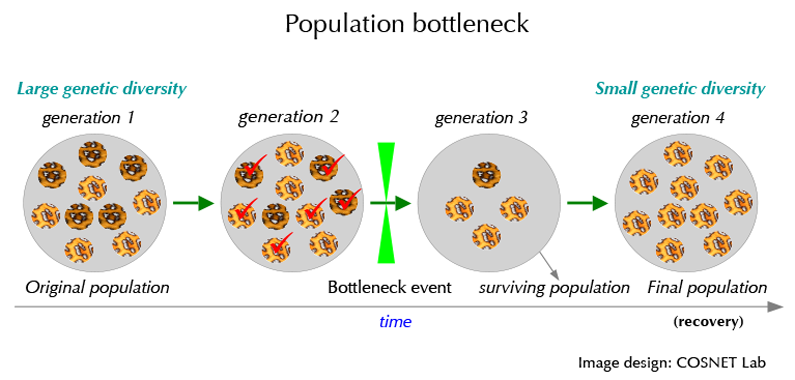
- Generation 1: The frequency of alleles in the population is the same.
- Generation 2: Randomly and due to a catastrophic natural or man-made event, most of individuals of the population died (there is no influence of adaptive pressures).
- Generation 3: As a result, the original large population is reduced to a small population composed by few individuals. This new surviving population subset contains much less genetic variability than the previous population.
- Generation 4: Later, the drastic reduction in the population size is followed by an expansion (population is recovered). The final population is no longer genetically representative of the original one. In this particular case, an allele is completely removed from the gene pool.
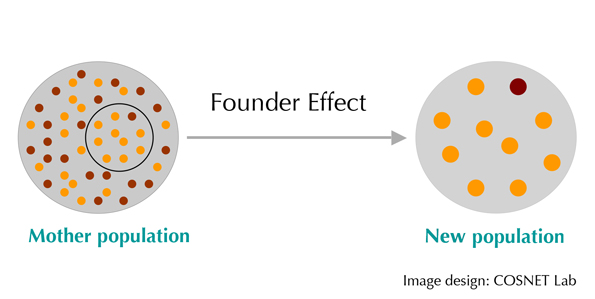 A new population is established by a small number of individuals that are cleaved from the original population. This leads to a loss of genetic variability as the founders of the new colony are not genetically representative at all of the population from which they come from. The right figure shows an evident predominance of orange circles in the newly founded population. These orange circles may correspond to a given allele responsible for the variation in a trait (for example, specific eyes color). In extreme cases, founder effect also plays a fundamental role in the emergence of new species.
A new population is established by a small number of individuals that are cleaved from the original population. This leads to a loss of genetic variability as the founders of the new colony are not genetically representative at all of the population from which they come from. The right figure shows an evident predominance of orange circles in the newly founded population. These orange circles may correspond to a given allele responsible for the variation in a trait (for example, specific eyes color). In extreme cases, founder effect also plays a fundamental role in the emergence of new species.Amish people in Pennsylvania, U.S. are a clear example of this event. The fact of being social and culturally isolated and the tendency to marry within the community (group interbreeding) make that certain types of genetic disorders like Ellis-van Creveld Syndrome are transmitted from one generation to another with a high probability. The above syndrome was first described in 1940 by Richard W. Ellis and Simon van Creveld and is characterized by a skeletal dysplasia. Some of the features of this rare condition are: disproportionate dwarfism, postaxial polydactyly, small chest, high frequency of congenital heart defects, among others. Most inherited genetic diseases are recessive. This means that a person must inherit two copies of the mutated gene to inherit a disorder. In this kind of populations, endogamy contributes to the latter.

3.- Mutations. Viral evolution/ Case:
Influenza virus
Mutation can be defined as a change in the DNA sequence within a gene or chromosome of a living organism. Many mutations are neutral, i.e. they can neither harm nor benefit, but can also be deleterious or beneficial. Deleterious mutations can affect the phenotype and in turn, reduce the fitness of an organism and increase the susceptibility to several illnesses and disorders. On the other hand, beneficial mutations can lead to the reproductive success and adaptability of an organism to its environment. These beneficial mutations can be spread and fixed in the population due to natural selection processes if they help individuals in the population to reach sexual maturity and to successfully reproduce. Mutations are, undoubtedly, a source of genetic variation and serve as a raw material for evolution to act. Germ line mutations occur in gametes (eggs or sperm cells) and can be pass on to offspring, whereas somatic mutations occur in non-reproductive cells and are not pass on to the following generation. Those mutations that occur in germ line are the most important to large-scale evolution because they can be transmitted to offspring.
Mutations can be spontaneous (errors during a normal process of DNA replication, spontaneous lesions and transposable genetic elements), but they can also be induced by numerous external or exogenous factors like environmental chemical agents or ionizing radiation, for example. According to their magnitude (mutations can occur at different levels), they can be divided into three different groups: Gene mutations, chromosome mutations and genome mutations. The DNA is constantly subject to mutations, thus its sequence can be altered in several different ways. A gene mutation can be defined as any change in the sequence of nucleotides of the genetic material of an organism. A chromosome mutation is a change in the structure or arrangement of the chromosomes. These mutations can involve duplications or deletions of chromosome segments, inversions of sections of DNA (reversed positions) and translocation. Genome mutations are alterations in the number of chromosomes in the genome. They can be classified into two groups: Aneuploidy and Euploidy. Aneuploidy is the losses and/or gains of individual chromosomes from the normal chromosome set arising from errors in chromosome segregation, and Euploidy refers to variations in complete sets of chromosomes.

US Department of Energy
Chromosome: A thread-like structure found in the nucleus of living cells that carries genetic information in the form of genes. Chromosomes come in pairs.
Gene: A unit of hereditary information consisting of a sequence of DNA that occupies a specific location on a chromosome and determines a particular characteristic of an organism. Every person has two copies of each gene, one inherited from each parent. Different versions of the same gene are called alleles. They determine how physical traits are expressed in a given individual.
DNA (Deoxyribonucleic acid): A long double-stranded nucleic acid molecule arranged as a double helix and joined by hydrogen bonds between the complementary bases: Adenine and Thymine or Cytosine and Guanine. It is the main constituent of chromosomes and it is the responsible for the transmission of hereditary characteristics from parents to offspring. The sequence of nucleotides determines individual hereditary characteristics.
Genome: The complete genetic material of an organism which is contained in the chromosomes, including the genes and DNA sequences.
Viruses, despite not being considered living entities are also subject to evolutionary pressures, mutations and
natural selection. The real problem when assigning this classification to viruses comes from the fact that they do not have a cellular structure and they are obligate intracellular parasites. Viruses do not possess a cell membrane in the sense of a phospholipid bilayer or metabolize on their own and they need to hijack the machinery of the cell to reproduce. Viruses cannot reproduce outside a living cell. Their real position in the tree of life continues to generate controversy in the scientific community as they move in a thin boundary line between the living and the nonliving. Viruses have a simple genome that contains the genetic information encoded in either DNA or RNA and also high replication and mutation rates. Influenza viruses, for example, are RNA viruses belonging to the family Orthomyxoviridae. There are three types of flu viruses: A, B, and C. Influenza type A viruses can eventually cause severe illness and are the unique responsible for Influenza human pandemics. They are subdivided into differente subtypes based on the two antigenic proteins on the surface of the virus: Hemagglutinin (HA) and Neuraminidase (NA). These viruses are formed by eight single-stranded RNA segments and have a very high rate of mutation (the error rate of the viral RNA-polymerase is 1000 times higher than the error rate of the human DNA- polymerase). Thus, replication of RNA viral genomes is error-prone and leads to several mutations on which natural selection can act. Mutations in viral RNA together with recombinations of RNA have led to viral evolution. The high mutation rates, the existence of large population sizes and short generation times are the fundamental features that have contributed to the rapid evolution of viruses. Interesting Review on Viral Evolution. S. Manrubia and E. Lázaro.
natural selection. The real problem when assigning this classification to viruses comes from the fact that they do not have a cellular structure and they are obligate intracellular parasites. Viruses do not possess a cell membrane in the sense of a phospholipid bilayer or metabolize on their own and they need to hijack the machinery of the cell to reproduce. Viruses cannot reproduce outside a living cell. Their real position in the tree of life continues to generate controversy in the scientific community as they move in a thin boundary line between the living and the nonliving. Viruses have a simple genome that contains the genetic information encoded in either DNA or RNA and also high replication and mutation rates. Influenza viruses, for example, are RNA viruses belonging to the family Orthomyxoviridae. There are three types of flu viruses: A, B, and C. Influenza type A viruses can eventually cause severe illness and are the unique responsible for Influenza human pandemics. They are subdivided into differente subtypes based on the two antigenic proteins on the surface of the virus: Hemagglutinin (HA) and Neuraminidase (NA). These viruses are formed by eight single-stranded RNA segments and have a very high rate of mutation (the error rate of the viral RNA-polymerase is 1000 times higher than the error rate of the human DNA- polymerase). Thus, replication of RNA viral genomes is error-prone and leads to several mutations on which natural selection can act. Mutations in viral RNA together with recombinations of RNA have led to viral evolution. The high mutation rates, the existence of large population sizes and short generation times are the fundamental features that have contributed to the rapid evolution of viruses. Interesting Review on Viral Evolution. S. Manrubia and E. Lázaro.

Influenza Virus. Image: Centers for Disease Control and prevention (CDC).
Antigenic drift is a minor change in the antigenic protein structure (HA and NA) in Influenza type A strains. These minor changes are produced by the accumulation of spontaneous mutations in genes encoding these surface proteins. Drift is an ongoing process that conducts to the emergence of new virus strains. When these minor changes occur, antibodies only provide a limited protection or partial immunity against the new strain, basically due to older exposures. This is the reason why people get flu more than on time throughout their lives, since the antibodies previously produced against the older strains no longer recognize the new virus
strain and as a consequence, they are not effective anymore in fighting and controlling the infection. For this specific reason, flu vaccines have to be modified every year based on the strains that are supposed to circulate
each season.
strain and as a consequence, they are not effective anymore in fighting and controlling the infection. For this specific reason, flu vaccines have to be modified every year based on the strains that are supposed to circulate
each season.
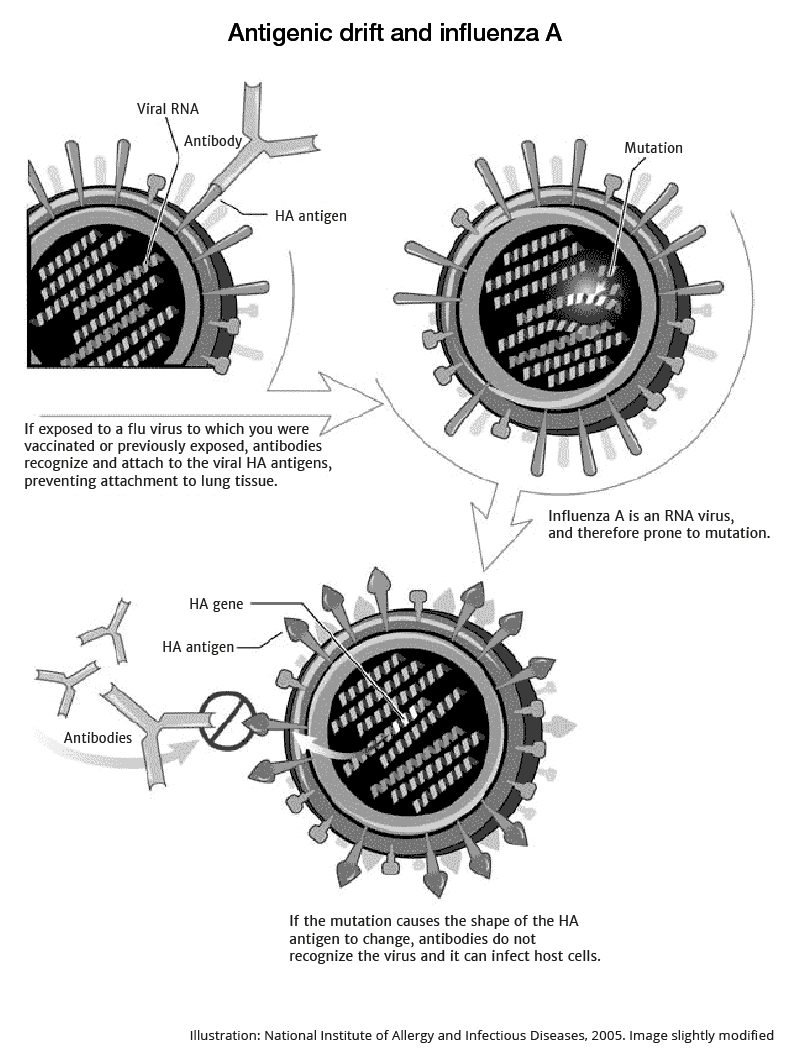
On the other hand, Antigenic shift is the process according to which at least two different strains of a flu virus are combined, giving rise to a new subtype with a new genetic material. In other words, it is a result of recombination events between different viral strains that infect the same cell and combine. The surface viral proteins are replaced by significantly different HA and NA. These radical changes lead to the emergence of new Influenza A virus subtype that has never circulated among the population and thus, most individuals are not immune against it. If this new virus were able to cause severe illness and could spread easily from one person to another through various regions or continents, then a (flu) pandemic would occur. While influenza viruses are changing all the time by the antigenic drift mechanism, antigenic shift only occurs occasionally.

4.- Gene Flow
In population genetics, Gene Flow (also known as gene migration) refers to the transfer of genes from the gene pool of one population to another. Gene flow may change the frequency and/or the range of alleles in the populations due to the migration of individuals or gametes that can reproduce in a different population. The introduction of new alleles increases variability within a population and allows for new combinations of traits. Horizontal gene transfer (HGT) also known as lateral gene transfer (LGT), is a process in which an organism (recipient) acquires genetic material from another one (donor) by asexual means. It is already known that HGT has played a major role in the evolution of many organisms like bacteria. In plant populations, the great majority of cases linked to this mechanism have to do with the movement of DNA between mitochondrial genomes. Horizontal gene transfer is a widespread phenomenon in prokaryotes, but the prevalence and implications of this mechanism in the evolution of multicellular eukaryotes is still unclear. Nevertheless, many investigations on HGT in plants have been carried out during the last years trying to reveal the underlying patterns, magnitude and importance of this mechanism in plant populations as well as its influence on agriculture and the ecosystem.
Plant populations can experience gene flow by spreading their pollen long distances away to other populations by means of wind or through birds or insects (bees, for example) and once there, this pollen is able to fertilize the plants where it ended up. Pollen is a fine to coarse powder containing the microgametophytes of seed plants, which produce the male gametes (comparable to sperm cells). Of course, pollination does not always lead to fertilization.
Maintained gene flow also acts against speciation by recombining the gene pools of different populations and in such a way, repairing the developing differences in genetic variation. Thus, gene flow has the effect of minimizing the genetic differences between populations.
Human migrations have occurred throughout the history of mankind and are defined as the movement of people from one place to another. However, in a genetic context, this movement needs to be associated with the introduction of new alleles into a population through successful mating of individuals from different populations.


